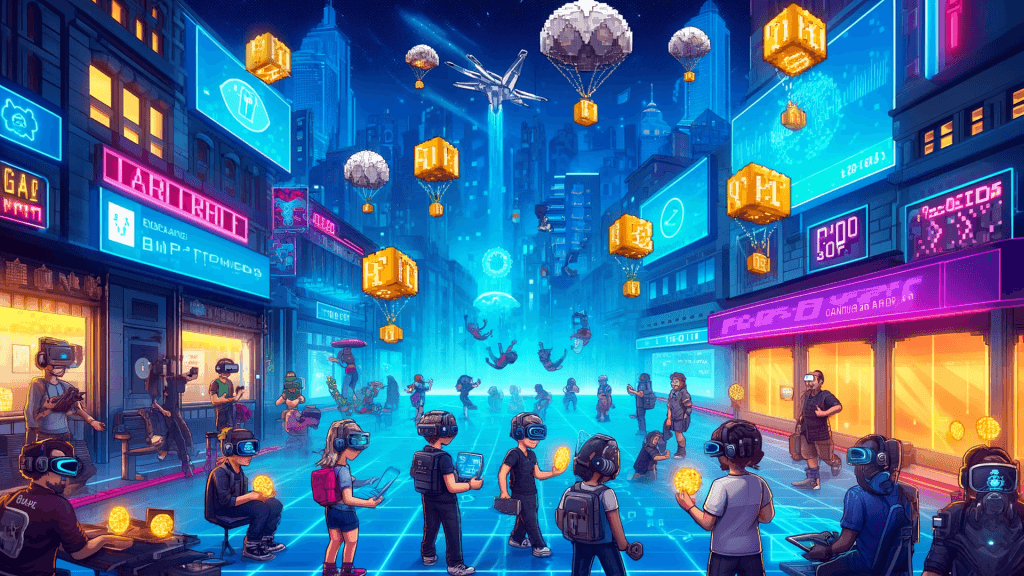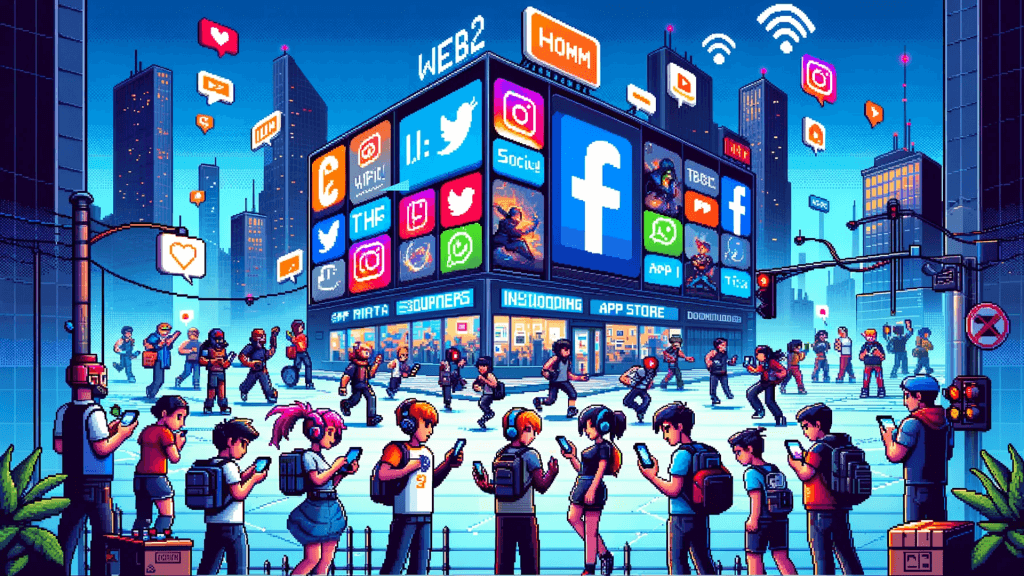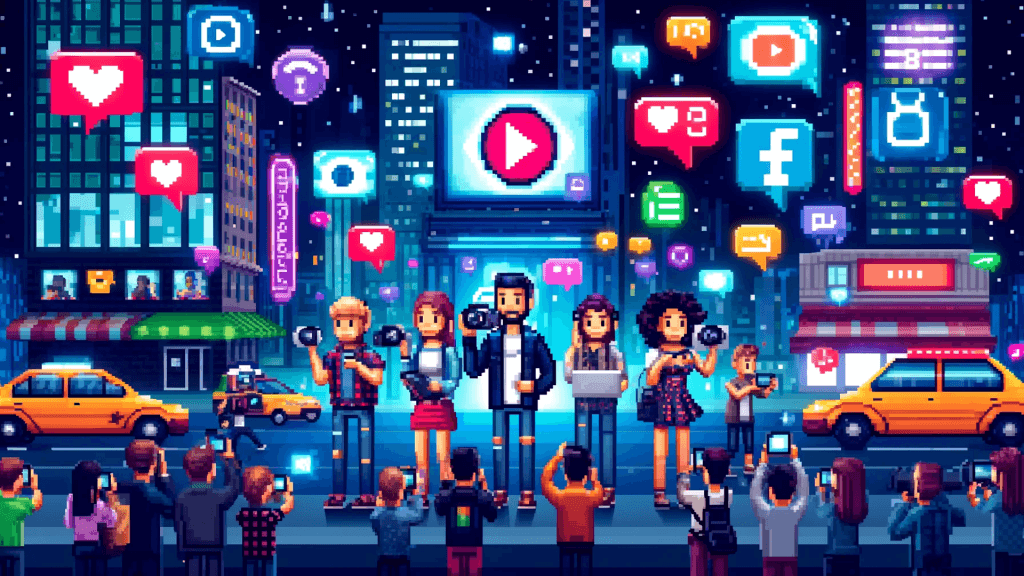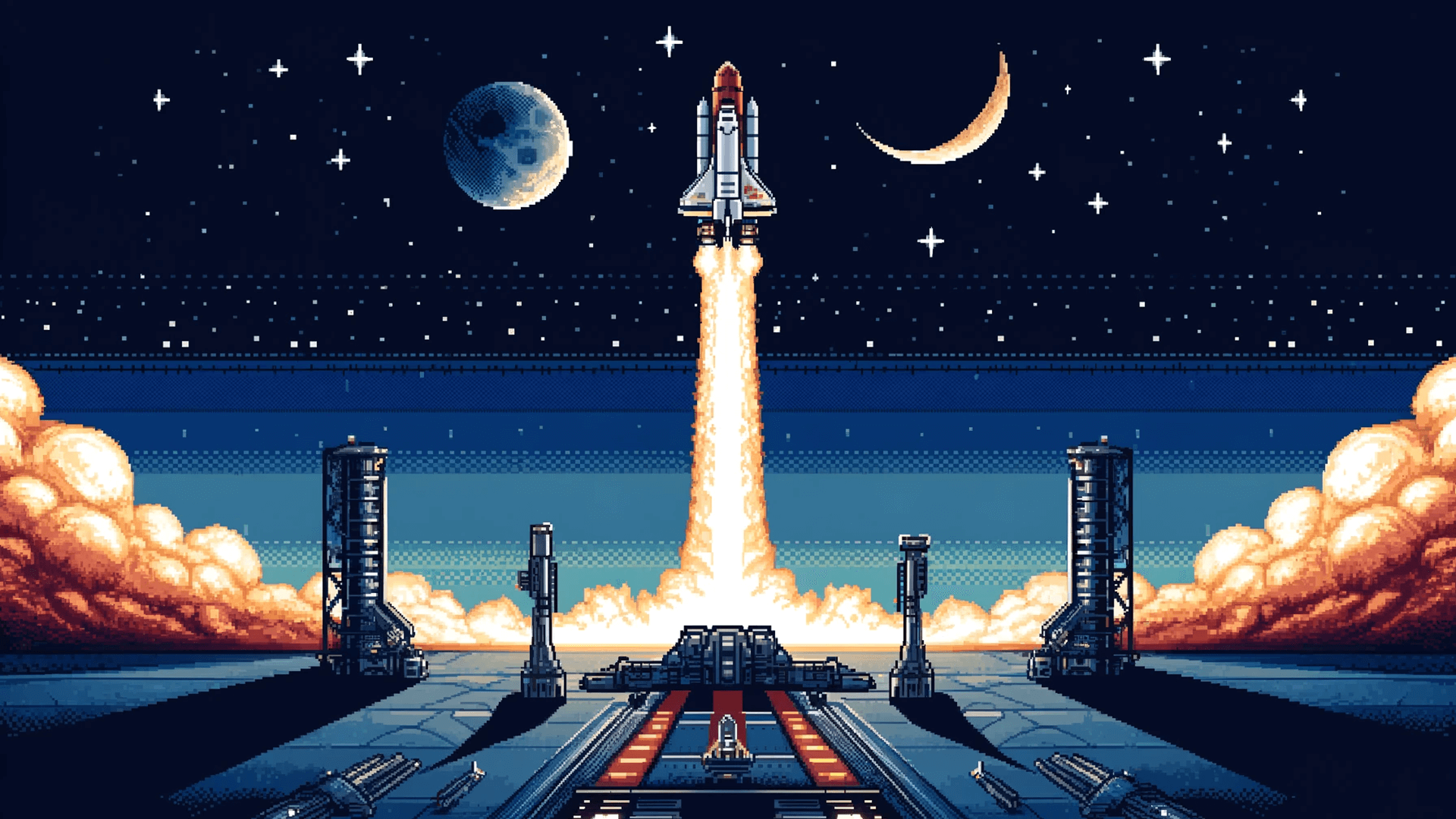If you’ve created an amazing web3 game, your next step is to launch it so gamers everywhere can find and enjoy it! However, marketing web3 games can be complex and challenging. This article will delve into the latest best practices for marketing web3 games, helping you navigate this tricky landscape and ensure your game is positioned for success.
- User acquisition for web3 games
- Web3 degen user acquisition tactics
- Web2 gamer user acquisition tactics
- User acquisition tactics for all gamers
- Key takeaways
User acquisition for web3 games
Increasingly, web3 game marketers are finding that for the best success, there are two target demographics that are key to target and convert: web3 degens and web2 gamers. Generally, it makes the most sense to target web3 degens earlier in game development and launch. These are the gamers who will take advantage of mints, NFTs, and marketplaces – providing early opportunities for funding.
Additionally, web3 degens tend to shun ads, so engaging with them in online communities and building word-of-mouth marketing early in game development is essential. However, the web3 gaming population is small and niche. So, to achieve more mainstream adoption, it’s best to shift toward targeting web2 gamers upon game launch.
Web3 degen user acquisition tactics
Web3 degens may shun ads, but they love personal engagement, digital asset ownership, early access opportunities. Not only are they prime candidates for token mints and NFT collections, but they can make for great alpha- and beta-testers – as well as provide great grassroots advertising. Here are some key ways to engage web3 gamers.

Quests and airdrops
Airdrops and quests are powerful tools in the web3 marketing arsenal, designed to captivate and engage your audience effectively.
Airdrops are free digital gifts, such as tokens or NFTs, sent directly to users’ wallets. They serve as excellent introductory gestures to raise brand awareness and encourage initial interaction with your platform. When planning an airdrop, consider the target audience and the value of the tokens being distributed. A well-timed airdrop can create buzz and excitement, drawing new users to your game and incentivizing them to explore further.
Quests are instantly rewarded tasks or challenges that users can complete to earn rewards. These tasks can range from simple actions, like following social media channels, to more involved activities, such as participating in community events or contributing content. The key to designing effective quests is to balance the effort required with the value of the reward. Users should feel that their time and effort are well-compensated, fostering a sense of achievement and loyalty.
To maximize engagement, consider incorporating variable rewards into your marketing strategy. Variable rewards can include rare tokens, exclusive NFTs, or entries into raffles for larger prizes. The element of surprise and the potential for high-value rewards can significantly enhance user motivation and participation. This unpredictability keeps users coming back, eager to see what they might win next, thereby increasing their interaction with you and your game.
Engage with web3 gamer communities
In web3 gaming, communities evolve from passive spectators to active participants who shape the game’s development and narrative. Community-driven development is essential, giving players a significant voice in the game’s direction. This involvement not only ensures the game resonates with its audience but also strengthens marketing efforts through direct engagement.
Although web3 degens are the best targets for NFTs and tokens, today’s gamers seek immersive and well-developed experiences over the mere incentive of NFT and token pre-sales. This shift in expectations highlights the need for genuine value creation within the game. Players are more likely to invest their time and resources in games offering rich content and compelling narratives.
To connect authentically with the web3 gaming community, focus on building genuine relationships through AMAs, livestreams, and user-generated content. Utilize decentralized platforms like Discord, where web3 gamers often congregate, to stay attuned to their preferences and foster direct, meaningful interactions. By prioritizing these elements, you can create a loyal, engaged community who become passionate advocates for your game.
- Learn how Sky Mavis drives growth for web3 games
- Learn how to develop better, more engaging web3 games
Web2 gamer user acquisition tactics
Having an engaged core community of web3 degens will provide many benefits for you early on in your game development. But for a chance at going mainstream, it’s critical to target web2 gamers once you launch your game. Here are some of the ways that targeting web2 gamers differs from targeting web3 gamers.

App store distribution and optimization
Major app store distribution (Apple’s App Store, Android’s Google Play, PC’s Steam, etc.) is key to getting web2 gamers in your game. These are trusted platforms and many web2 gamers only download games through these distribution channels. Similarly, app store optimization (ASO) is crucial for climbing the charts and capturing the attention of your target web2 audience.
With many web3 games now eligible for app store listings, ASO becomes an integral component of any web3 game’s marketing strategy. To excel in ASO, it’s essential to continuously iterate on key elements like the app’s logo, keywords, screenshots, videos, and descriptions. Regular updates to these components can significantly enhance visibility and appeal.
Maintaining high ratings is equally important for ASO success. This involves delivering a high-quality gaming experience and actively engaging with your player base. Swiftly responding to player feedback and addressing concerns demonstrates a commitment to user satisfaction, encouraging positive reviews and ratings.
Paid advertising and new growth hacks
In the realm of web2, gamers are highly responsive to traditional digital marketing techniques, making it significantly easier to scale a game compared to using web3 games growth strategies. The key is to identify the platforms most frequented by your target audience and craft ads tailored specifically for those platforms. Regular monitoring of ad performance and continual iteration are essential to maximize the effectiveness of these campaigns.
A notable trend in the growth of newer web3 games is the strategic use of traditional game growth channels, such as paid advertising on platforms like Google and TikTok. This approach aims to attract traditional gamers to web3 games without needing an understanding of web3 technologies or even the knowledge that they are engaging with a web3 game. By using familiar platforms and advertising methods, along with better onboarding, marketers can seamlessly introduce gamers to the web3 environment.
This strategy becomes even more potent when combined with a token launch or NFT minting event, as evidenced by Heroes of Mavia. Learn more about this strategy, which we’ve dissected to provide a powerful new web3 growth hack.
Traditional social media platforms
Web2 gamers are ubiquitous across all major mainstream social media platforms, including Facebook, Instagram, TikTok, Twitter, YouTube, and Twitch, among others. To effectively reach and engage with these gamers, it’s crucial to identify the platforms where your target audience is most active and establish a strong presence there.
- Facebook and Instagram: These platforms offer robust advertising tools and a diverse user base. Use visually appealing content, such as game trailers, character art, and behind-the-scenes looks, to capture attention. Engage with followers through regular posts, stories, and interactive polls.
- TikTok: With its rapid growth and younger demographic, TikTok is ideal for creating viral, short-form content. Utilize trending challenges, memes, and hashtag campaigns to increase visibility. Partnering with influencers and leveraging user-generated content (UGC) can significantly boost engagement.
- Twitter (X): This platform is excellent for real-time updates and community engagement. Use Twitter (X) to announce game updates, share quick tips, and engage in conversations with players. Regularly host Twitter Spaces (X Spaces) for live discussions and Q&A sessions to deepen connections with your audience.
- YouTube: As a hub for video content, YouTube is perfect for in-depth game trailers, developer diaries, and gameplay tutorials. Create a channel dedicated to your game, and encourage players to subscribe for regular content. Engage with the community through comments and live streaming events.
- Twitch: Ideal for live streaming, Twitch allows you to showcase gameplay, host live Q&A sessions, and engage with viewers in real-time. Regular streams can help build a loyal community. Collaborate with popular streamers to reach a wider audience and create hype around your game.
- Reddit: With subreddits dedicated to games and gaming, Reddit is the perfect place to hone in on gamers and engage with them. Reddit’s AMAs (Ask Me Anything) are also the perfect platform to allow players to engage with your game studio directly, fostering transparency, trust, and loyalty.
User acquisition tactics for all gamers
Beyond the distinct tactics and platforms for web2 and web3 gamers, there are several strategies and places to effectively engage both groups. Leveraging influencers, optimizing for SEO, implementing content marketing, and encouraging user-generated content (UGC) are among a few of the versatile approaches that can drive success across both gaming communities.

Influencer marketing
Influencers have played a pivotal role in marketing since the advent of social media, and even before that in various forms. In the web2 space, influencers are often YouTubers, Instagrammers, TikTokers, and other social media personalities with dedicated followings. These influencers have built substantial audiences through engaging content, relatable personas, and consistent interaction with their followers.
In the web3 space, influencers take on a slightly different role. Here, they can be trendsetters, key connectors, thought leaders, and community organizers who are deeply embedded in the blockchain and cryptocurrency ecosystems. These influencers often have a profound understanding of decentralized technologies and command significant respect and trust within their communities.
Whether your target audience comprises web2 or web3 gamers, the key to successful influencer marketing lies in forging authentic and impactful collaborations. By partnering with the right influencers and creating authentic, engaging content, you can effectively reach and engage both web2 and web3 gamers, driving awareness and growth for your game.
- Questions you should always ask influencers before signing a deal
- Influencer marketing strategies from Gamesight and Lucky Axolotl
Content marketing
Creating evergreen content – such as videos, blogs, and infographics – can effectively engage both web2 and web3 audiences. This type of content remains relevant and valuable over time, providing ongoing engagement and driving consistent traffic to your platforms. Here’s how to make the most of evergreen content to target both web2 and web3 gamers:
- Videos: Produce a variety of video content that appeals to both web2 and web3 gamers. This could include behind-the-scenes footage of game development, developer interviews, gameplay tutorials, and updates on game features. High-quality, engaging video content can attract and retain a diverse audience.
- Blogs: Write detailed blog posts covering a range of topics relevant to both communities. These can include articles on game updates, world-building lore, character development, and strategy guides. Blogs help establish your authority, provide valuable information to your audience, and can assist your SEO initiatives.
- Infographics: Create visually appealing infographics that simplify complex concepts, such as game mechanics, development processes, or the integration of blockchain elements in web3 games. Infographics are easily shareable and can quickly convey information, making them a valuable addition to your content strategy.
To ensure your content resonates with both web2 and web3 audiences, cover a breadth of topics that cater to the interests of both groups:
- Behind-the-scenes: Share insights into the game development process. Videos or blogs featuring interviews with developers, sneak peeks at upcoming features, and explanations of game design decisions can captivate gamers from both web2 and web3 backgrounds.
- Game updates: Regularly update your audience on new features, patches, and upcoming content. Detailed patch notes, video breakdowns, and blogs about the latest updates keep your community informed and engaged.
- World-building: Dive deep into the lore and world-building aspects of your game. Articles, videos, and infographics that explore the history, characters, and environments within your game can attract gamers who appreciate rich storytelling and immersive worlds.
- Educational content: Provide educational content that makes your game more accessible. This can include tutorials, explainer videos, and blog posts that make complex concepts or potential hurdles more accessible to a broader audience.
Search engine optimization (SEO)
Web searches provide a critical opportunity to reach both web2 and web3 gamers. By strategically optimizing your content for relevant keywords, you can enhance your visibility and attract a diverse audience. Here’s how to effectively target both groups through search engine optimization (SEO):
Keyword strategy
- Identify shared keywords: Focus on broad, high-volume keywords that are relevant to both web2 and web3 gamers. These might include terms related to your game genre, popular game features, or general gaming topics. For example, keywords like “best RPG games” and “multiplayer strategy games” can attract a wide audience.
- Target specific keywords: Don’t hesitate to use specific keywords tailored to each group. For web2 gamers, emphasize traditional gaming terms such as “console gaming tips,” “PC game reviews,” or “top indie games.” For web3 gamers, target keywords related to blockchain technology, NFTs, and decentralized gaming, such as “blockchain games,” “NFT game assets,” or “play-to-earn games.”
- Low-competition, high-volume keywords: Conduct thorough keyword research to identify terms that have high search volume but low competition. Tools like Moz, MarketMuse, or Surfer can help you find these valuable keywords. By targeting these terms, you can improve your chances of ranking higher in search results and attracting more organic traffic.
Content optimization
- On-page SEO: Ensure that your content is optimized for the identified keywords. This includes using the keywords in strategic locations such as the title, headings, meta descriptions, and throughout the body of the content. However, avoid keyword stuffing, and aim for natural and relevant integration of the terms.
- High-quality content: Create content that is informative, engaging, and valuable to your audience. High-quality content is more likely to rank well in search results and attract backlinks from other sites, further boosting your SEO efforts.
- User experience: Optimize your website for a seamless user experience. This includes fast loading times, mobile responsiveness, easy navigation, and a clean, appealing design. A positive user experience can reduce bounce rates and improve your search rankings.
- Content variety: Diversify the format of your content to cater to different search intents. This could include blog posts, how-to guides, video tutorials, infographics, and interactive content. Providing a variety of content types can help capture the interest of a broader audience.
Monitoring and iterating
- Track performance: Use analytics tools like Google Analytics and Search Console to monitor the performance of your keywords and content. Track metrics such as organic traffic, bounce rates, and conversion rates to assess the effectiveness of your SEO strategy.
- Adjust strategies: Based on your performance data, adjust your keyword strategy and content optimization efforts. If certain keywords are not performing well, consider refining your approach or targeting different terms. Continuous optimization is key to maintaining and improving your search rankings.
Host online events
Online events (also known as virtual events) offer a dynamic platform to engage the gaming community, providing opportunities for users to connect, interact, and build relationships. These events are not just about showcasing your game; they are also about creating a vibrant, interactive community. Here are some examples of virtual events that can effectively engage both web2 and web3 gamers:

- Artist showcases or exhibits: Host virtual galleries or showcases where artists can display game-related artwork, including concept art, character designs, and fan art. These events can be interactive, allowing attendees to ask questions, purchase art, or even participate in live drawing sessions.
- Educational sessions: Organize educational workshops that delve into various aspects of your game or gaming in general. Topics can range from game development and design to blockchain technology and NFTs. These sessions can help both web2 and web3 gamers deepen their understanding of the industry and your game.
- Online expos: Virtual expos can mimic the experience of physical gaming conventions. Set up virtual booths where attendees can explore different aspects of your game, watch live demos, and interact with your team. These expos can also include panels and keynote presentations from your studio – or other industry experts.
- Webinars: Host informative webinars covering a wide range of topics relevant to your audience. Webinars can include deep dives into game mechanics, discussions on the future of gaming, and insights into the integration of web3 technologies.
- AMAs (Ask Me Anything): Conduct AMAs on platforms like Reddit, Discord, or Twitter. These sessions allow your community to ask you questions directly, creating a transparent and engaging dialogue. AMAs are an excellent way to build trust and address any concerns or curiosities your audience might have.
- Town hall style meetings: Regularly scheduled town hall meetings can be a great way to keep your community informed about game updates, upcoming features, and development progress. These meetings provide a forum for open communication, where players can voice their opinions and provide feedback.
Leveraging virtual events
- Connecting with your audience: Use virtual events to establish a direct line of communication with your audience. Interact with attendees, answer their questions, and show them that their opinions and feedback are valued. This interaction can help build a strong, loyal community around your game.
- Educating gamers: Virtual events are an excellent platform for educating both web2 and web3 gamers about your game. Whether it’s explaining game mechanics, introducing blockchain features, or sharing the lore of your game world, these events can help players gain a deeper understanding and appreciation of your game.
- Sourcing innovative ideas: Engage with your community to source innovative ideas and suggestions. Encourage attendees to share their thoughts and feedback during these events. This input can provide valuable insights and help you identify potential improvements or new features.
- Tackling potential problems early: Use virtual events as an opportunity to address any potential issues or concerns early on. By maintaining open communication with your community, you can quickly identify and resolve problems before they escalate, ensuring a smoother gaming experience for your players.
By hosting a variety of virtual events, you can create a dynamic and engaging environment for both web2 and web3 gamers. These events not only help in building a strong community but also provide valuable opportunities to educate your audience, gather innovative ideas, and address potential issues proactively.
Take advantage of user-generated content (UGC)
Word-of-mouth has always been a powerful marketing tool, and in the digital age, user-generated content (UGC) is its turbocharged counterpart. With the rise of social media and digital platforms, anyone can become a content creator. UGC can significantly boost marketing efforts in web2 and web3 by fostering a sense of community and ownership among gamers, while also extending the reach of your game. Here are some effective UGC-driven strategies:
- Showcase player content: Highlight user-generated content on your official channels. Whether it’s fan art, fan fiction, or gameplay videos, featuring player contributions on your website and social media pages can inspire others to participate and share their creations.
- Provide prompts and challenges: Spark creativity by providing prompts for fan art and fan fiction. Hosting themed contests or challenges can motivate players to create content related to your game. This not only generates more UGC but also keeps your community engaged.
- Feature community streamers: Identify and promote streamers within your community. Recognizing and supporting these content creators can help build a loyal following and increase visibility for your game. Streamers often have dedicated audiences who trust their opinions, making them powerful advocates for your game.
- Photo contests: If your game includes a photo mode, hold regular photo contests. Encourage players to capture and share their best in-game moments. This can create a vibrant collection of images that showcase your game’s visuals and gameplay, attracting potential new players.
Elevating UGC in Web3
Web3 technology elevates UGC by allowing players to create, trade, and sell in-game assets. Here’s how to support and enhance web3 user-generated content:
- Provide creation tools: Equip content creators with the tools and resources they need to create in-game assets. Comprehensive creation kits and easy-to-use tools can empower players to design unique items, characters, or environments that can be integrated into your game.
- Facilitate asset integration: Ensure that player-created assets can be seamlessly integrated into your game. Providing clear guidelines and support for asset integration can help maintain a cohesive game experience while showcasing player creativity.
- Support marketplace trading: Foster a thriving marketplace where players can trade and sell their creations. Supporting platforms that facilitate asset trading can enhance the overall gaming experience and create additional revenue streams for both the game studio and asset creators.
- Enforce royalties: Promote platforms that enforce royalties for content creators. This not only incentivizes creators to produce high-quality content but also ensures they are fairly compensated for their contributions, fostering a sustainable and rewarding ecosystem.
By embracing and promoting user-generated content, you can cultivate a vibrant, engaged community around your game. Encouraging creativity and providing the tools and platforms for content creation and distribution can significantly enhance your marketing efforts and contribute to the long-term success of your game.
Key takeaways
Marketing your web3 game can be a challenging endeavor, but with the right strategies, it can also be incredibly rewarding. By targeting both web2 and web3 gamers with tailored approaches, leveraging user-generated content, and engaging in authentic community interactions, you can build a robust and loyal player base. As you navigate the complexities of web3 marketing, remember that fostering a sense of community and providing genuine value to your players will be the cornerstone of your success.
Further reading
- Web3 Games Publishing: What are web3 games – and how to get started?
- Web3 Growth Opportunities for game developers and marketers
- Web3 Gaming + Web3 Marketing: What You NEED to Know
If you’re ready to level up your web3 game, check out our platform or reach out to us today!
Keep up with the latest insights from Upptic
Sign up for our monthly newsletter

